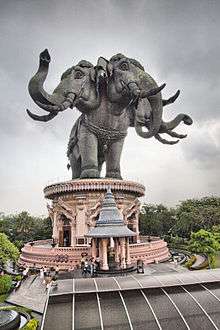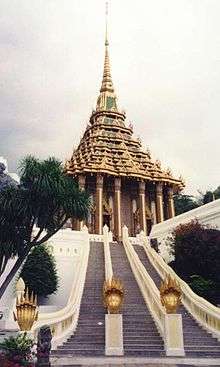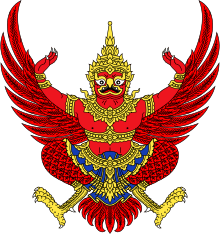Tourism in Thailand
Tourism is a major economic contributor to the Kingdom of Thailand. Estimates of tourism receipts directly contributing to the Thai GDP of 12 trillion baht range from 9 percent (one trillion baht) (2013) to 17.7 percent (2.53 trillion baht) in 2016.[1][2] When including indirect travel and tourism receipts, the 2014 total is estimated to have accounted for 19.3 percent (2.3 trillion baht) of Thailand's GDP.[3]:1
Tourism worldwide in 2017 accounted for 10.4 percent of global GDP and 313 million jobs, or 9.9 percent of total employment.[4]:1 Most governments view tourism as an easy moneymaker and a shortcut to economic development. Tourism success is measured by the number of visitors; the more, the better.[5]
The Tourism Authority of Thailand (TAT) uses the slogan "Amazing Thailand" to promote Thailand internationally. In 2015, this was supplemented by a "Discover Thainess" campaign.[6]
Overview
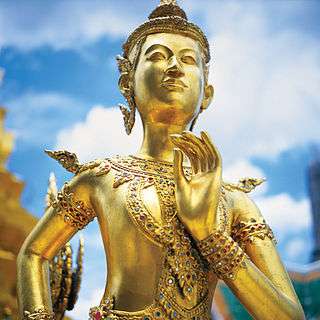
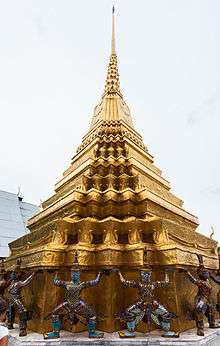
Among the reasons for the increase in tourism in the 1960s were the stable political atmosphere and the development of Bangkok as a crossroads of international air transport.[7] The hotel industry and retail industry both expanded rapidly due to tourist demand. It was boosted by the presence of US GIs who arrived in the 1960s for rest and recuperation (R&R) during the Vietnam War.[8] During this time, international tourism was becoming the new trend as living standards increased throughout the world and travel became faster and more dependable with the introduction of new technology in the air transport sector.[9]
Tourist numbers have grown from 336,000 foreign visitors and 54,000 GIs on R&R in 1967[8] to 32.59 million foreign guests visiting Thailand in 2016.[10][11][12] The Tourism Authority of Thailand (TAT) claims that the tourist industry earned 2.52 trillion baht (US$71.4 billion) in 2016, up 11 percent from 2015.[10] TAT officials said their revenue estimates, for foreign and domestic tourists combined, show that tourism revenue for all of 2017 may surpass earlier forecasts of 2.77 trillion baht (US$78.5 billion).[10]
In 2015, 6.7 million persons arrived from ASEAN countries and the number is expected to grow to 8.3 million in 2016, generating 245 billion baht.[13] The largest numbers of Western tourists came from Russia (6.5 percent), the UK (3.7 percent), Australia (3.4 percent) and the US (3.1 percent).[14] Around 60 percent of Thailand's tourists are return visitors.[15] The peak period is from December to February.
In 2014, 4.6 million Chinese visitors travelled to Thailand.[14][16] In 2015, Chinese tourists numbered 7.9 million or 27 percent of all international tourist arrivals, 29.8 million; 8.75 million Chinese tourists visited Thailand in 2016.[17][13] In 2017, 27% of the 9,194,057 tourists that came to Thailand came from China.[18] Thailand relies heavily on Chinese tourists to meet its tourism revenue target of 2.2 trillion baht in 2015 and 2.3 trillion in 2016.
It is estimated that the average Chinese tourist remains in the country for one week and spends 30,000–40,000 baht (US$1,000–1,300) per person, per trip.[19] The average Chinese tourist spends 6,400 baht (US$180) per day—more than the average visitor's 5,690 baht (US$160).[13][16] According to Thailand's Tourism Authority, the number of Chinese tourists rose by 93 percent in the first quarter of 2013, an increase that was attributed to the popularity of the Chinese film Lost in Thailand that was filmed in the northern province of Chiang Mai. Chinese media outlets have claimed that Thailand superseded Hong Kong as the top destination for Chinese travellers during the 2013 May Day holiday.[20] In 2013, the Chinese National Tourism Administration published A Guide to Civilized Tourism which has specific statements regarding how to act as a tourist in Thailand.[21]
In 2015, Thailand hosted 1.43 million Japanese travellers, up 4.1 percent from 2015, generating 61.4 billion baht, up 6.3 percent. In 2016, Thailand expects 1.7 million Japanese tourists, generating 66.2 billion baht in revenue.[22]
To accommodate foreign visitors, the Thai government established a separate tourism police force with offices in the major tourist areas and its own central emergency telephone number.[23]
Since the opening of the Vietnam, Cambodia, and Laos borders in the late 1900s, competition has increased because Thailand no longer has the monopoly on tourism in Southeast Asia.[24] Destinations like Angkor Wat, Luang Prabang and Halong Bay now rival Thailand's former monopoly in the Indochina region. To counter this, Thailand is targeting niche markets such as golf holidays, holidays combined with medical treatment or visits to military installations.[17] Thailand has also plans to become the hub of Buddhist tourism in the region.[25]
International rankings
In the MasterCard 2014 and 2015 Global Destination Cities Index, Bangkok ranked the second of the world's top-20 most-visited cities, trailing only London.[26][27] The U.S. News' 2017 Best Countries report ranked Thailand at 4th globally for adventure value and 7th for cultural heritage.[28]
The Travel and Tourism Competitiveness Report 2015 published by the World Economic Forum ranked Thailand 35 of 141 nations. Among the metrics used to arrive at the rankings, Thailand scored high on "Natural Resources" (16 of 141 nations) and "Tourist Service Infrastructure" (21 of 141), but low on "Environmental Sustainability" (116 of 141) and "Safety and Security" (132 of 141).[29][30]
In 2013, Thailand was the 10th "top tourist destination" in the world tourism rankings with 26.5 million international arrivals.[31]:6
In 2016, Bangkok ranked 1st surpassing London and New York in Euromonitor International's list of "Top City Destinations" with 21 million visitors.
In 2008, Pattaya was 23rd with 4,406,300 visitors, Phuket 31st with 3,344,700 visitors, and Chiang Mai ranked 78th place with 1,604,600 visitors.[32]
In a list released by Instagram that identified the ten most photographed locations worldwide in 2012, Suvarnabhumi Airport and Siam Paragon shopping mall were ranked number one and two respectively, more popular than New York City's Times Square or Paris's Eiffel Tower.[33]
2013–2015 Thai political unrest
At the commencement of 2014, the Thai tourist industry suffered due to the political turmoil that erupted in October 2013. A shutdown of Bangkok's governmental offices on 13 January 2014 by anti-government protesters, prompted some tourists to avoid the Thai capital. TAT forecasted that arrival numbers might drop by around five percent in the first quarter of 2014, with the total number of arrivals down by 260,000 from the original projection of 29.86 million. Tourism revenue is also expected to drop slightly from 1.44 trillion.[34]
Tourist arrivals in 2014 totalled 24.7 million, a drop of 6.6 percent from 2013. Revenues derived from tourism amounted to 1.13 trillion baht, down 5.8 percent from the previous year. Kobkarn Wattanavarangkul, Thailand's Minister of Tourism and Sports, attributed the decline to the political crisis in the first half of 2014 which dissuaded many potential visitors from visiting Thailand. Tourism officials also pointed to the dramatic fall in the value of the Russian ruble which has damaged the economies of popular Russian destinations such as Phuket and Pattaya.[35]
At the beginning of April 2015, Thailand ended martial law, to be replaced by Article 44 of the provisional constitution, granting unrestricted powers to the prime minister. The words "martial law" were toxic to foreign democracies, but, in terms of tourism, even more toxic to foreign travel insurance providers, who decline to provide insurance to those visiting nations under martial law. The tourism industry rebounded swiftly after the lifting of martial law. Deputy Prime Minister Pridiyathorn Devakula said that the arrival of high-spending tourists from Europe and the US is expected to increase.[36]
"Discover Thainess" tourist initiative
In order to reignite growth in Thailand's tourist industry, the Tourism Authority of Thailand (TAT) has embarked on a new campaign for 2015 entitled "2015: Discover Thainess".[6][37] TAT Governor Thawatchai Arunyik said the campaign will incorporate the "twelve values" that Thai junta leader and Prime Minister Prayut Chan-o-cha wants all Thais to practice.[35] TAT officials foresee a large increase in tourist numbers due to the "Discover Thainess" campaign. Ms Somrudi Chanchai, Director of the TAT Northeastern Office, has forecasted that tourists to her Isan region will increase by 27.9 million [sic] visitors, generating 65 billion baht in revenue.[38]
Climate
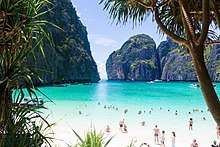
Thailand's popularity as a tourist destination owes a great deal to its benign climate. Thailand predominantly has a tropical wet and dry or savannah climate while the south and the eastern tip of the east have a tropical monsoon climate.[39]
Most of Thailand has three seasons:
- The cool dry season from late-November to February. Temperatures in December for Chiang Mai average around 15 Celsius at night, rising to around 28 Celsius during the day with clear sunny skies. Higher up in the mountains, temperatures may drop to near freezing at night. In Bangkok and in the central and northeastern plains of Thailand, midday temperatures during the cool dry season average around 30 Celsius and the humidity is much lower.
- The hot dry season from March to May can see daytime temperatures in the mid- to high-30s. This is the time for holding festivals (such as Songkran country wide and Rocket Festival) most celebrate in the Northeast region or the Isaan peoples living in other part of a country which favorite Rocket Festival in Roi Et province and Yasothon province to mark the coming of the rainy season.
- The rainy season from May to October has daytime temperatures in the low-30s with nighttime temperatures in the mid= to high-20s. Some areas have a relatively short rainy season, such as Ko Samui where it is typically only approximately six weeks, starting in October and running to November. Rain showers mainly occur late-afternoon or early-evening. Typically, humidity is high.
Deeper south on the Kra Isthmus with its tropical monsoon climate, daytime temperatures year-round tend to hover around 31 Celsius with only a marked increase in rainfall during the monsoons. The west coast is affected by monsoons from May to October, the southeast coast of the isthmus is affected from October to January.[40]
Statistics
Annual statistics
| Year | Arrivals | % change |
|---|---|---|
| 2027 | 67,655,000 | Forecast[43]:5 |
| Jan-Aug 2018 | 25,886,325 | [44] |
| 2017 | 35,381,210 | |
| 2016 | 32,588,303 | |
| 2015 | 29,881,091 | |
| 2014 | 24,809,683 | |
| 2013 | 26,546,725 | |
| 2012 | 22,353,903 | |
| 2011 | 19,230,470 | |
| 2010 | 15,936,400 | |
| 2009 | 14,149,841 | |
| 2008 | 14,584,220 | |
| 2007 | 14,464,228 | |
| 2006 | 13,821,802 | |
| 2005 | 11,516,936 |

In their justifications for constructing a new coal-fired power plant in Krabi Province (2015), the Electricity Generating Authority of Thailand (EGAT) presumes that by 2032 Thailand will receive more than 100 million tourists a year, 40 percent of them visiting Phuket and neighbouring areas such as Krabi. On average, the power consumption of a tourist is four times higher than that of a local resident.[46]
In 2015 some segments of Thailand's hospitality industry enjoyed their best year in over two decades, according to research firm STR Global. Thailand closed the year with an overall hotel occupancy of 73.4 percent, an increase of 13.6 percent over 2014, as arrivals rose to near the 30 million mark, driven by demand from the Chinese market. December 2015 was a particularly strong month as occupancy levels reached 77.4 percent, the highest level since 1995.[47]
Despite the increasing number of tourist arrivals, some businesses catering to the tourist trade report declining numbers. Mr Sompoch Sukkaew, chief legal counsel of the Patong Entertainment Business Association (PEBA) in Phuket, said in January 2016 that entertainment businesses are suffering. "Over the past three years, most bars were averaging about B90,000 revenue per day at this time of year,...now they're making just B40,000. Small bars...used to average B40,000 to B50,000 a day, now they're down to just B10,000 per day....PEBA members generated about B1.5 million per day during the peak season. Now it's down to about B540,000 per day." PEBA members number 500 in Patong, with about 200 businesses in the Bangla Road entertainment area. PEBA President Weerawit Kuresombat attributed the decline to the rise in Chinese tourism. "...most of them [Chinese tourists] come on complete tour packages....This means they spend very little on extras....They rarely venture out for the nightlife or even visit independent restaurants. They just don't spend much", he said.[48]
The Thai government expects revenue from foreign tourists to increase by 8.5 percent to 1.78 trillion baht (US$49.8 billion) in 2017. Deputy Prime Minister Thanasak Patimaprakorn attributed the increase to the improving outlook for global tourism as well as Thailand's investments in infrastructure. In 2016, Thailand had 32.6 million visitors, a rise of nearly nine percent from 2015. In 2017 the number of tourists visiting Thailand went up to 35 millions.[49] Thanasak expects daily tourist spending to increase to 5,200 baht per person in 2017, up from 5,100 baht in 2016.[45] Local tourists are expected to contribute an additional 950 billion baht in tourism revenues in 2017.[50]
Top 25 arrivals by nationality
| Rank | Country or territory | Jan-Aug 2018[44] | 2017 | 2016 | 2015 | 2014 | 2013 | 2012 | 2011 | 2010 | 2009 | 2008 | 2007 | 2006 |
|---|---|---|---|---|---|---|---|---|---|---|---|---|---|---|
| * | ASEAN | 6,556,045 | 9,119,941 | 8,658,051 | 7,886,136 | 6,641,772 | 7,282,266 | 6,281,153 | 5,594,577 | 4,534,235 | 3,968,579 | 3,971,429 | 3,520,051 | 3,389,342 |
| 1 | 7,728,385 | 9,805,753 | 8,757,466 | 7,934,791 | 4,636,298 | 4,637,335 | 2,786,860 | 1,721,247 | 1,122,219 | 777,508 | 826,660 | 907,117 | 949,117 | |
| 2 | 2,506,821 | 3,354,800 | 3,533,826 | 3,423,397 | 2,613,418 | 3,041,097 | 2,554,397 | 2,500,280 | 2,058,956 | 1,757,813 | 1,855,332 | 1,540,080 | 1,591,328 | |
| 3 | 1,199,192 | 1,709,070 | 1,464,218 | 1,372,995 | 1,122,566 | 1,295,342 | 1,263,619 | 1,156,283 | 885,445 | 758,227 | 889,210 | 1,183,652 | 1,092,783 | |
| 4 | 1,148,063 | 1,612,647 | 1,409,456 | 1,233,138 | 1,053,983 | 976,639 | 975,999 | 891,950 | 715,345 | 655,034 | 621,564 | 513,701 | 276,207 | |
| 5 | 1,089,589 | 1,544,328 | 1,439,629 | 1,381,690 | 1,267,886 | 1,586,425 | 1,373,716 | 1,277,893 | 993,674 | 1,004,453 | 1,153,868 | 1,277,638 | 1,311,987 | |
| 6 | 1,048,610 | 1,411,942 | 1,193,822 | 1,069,149 | 932,603 | 1,050,889 | 1,013,308 | 914,971 | 760,371 | 614,566 | 536,964 | 536,356 | 459,795 | |
| 7 | 950,765 | 1,346,219 | 1,089,992 | 884,085 | 1,606,430 | 1,746,565 | 1,316,564 | 1,054,187 | 644,678 | 336,965 | 324,120 | 277,503 | 187,658 | |
| 8 | 732,970 | 934,497 | 830,394 | 751,091 | 559,415 | 725,057 | 618,670 | 496,768 | 380,368 | 363,029 | 338,303 | 237,672 | 227,134 | |
| 9 | 727,490 | 1,056,124 | 974,632 | 867,520 | 763,520 | 823,486 | 768,638 | 681,748 | 611,792 | 627,074 | 669,097 | 681,972 | 694,258 | |
| 10 | 694,053 | 820,894 | 749,694 | 669,165 | 483,131 | 588,335 | 473,666 | 411,834 | 316,476 | 318,762 | 337,827 | 367,862 | 376,636 | |
| 11 | 667,185 | 1,028,077 | 966,909 | 937,311 | 844,133 | 955,468 | 831,215 | 682,364 | 603,538 | 563,575 | 570,047 | 604,603 | 687,160 | |
| 12 | 655,490 | 994,468 | 1,003,386 | 946,919 | 907,877 | 905,024 | 873,053 | 844,972 | 810,727 | 841,425 | 826,523 | 859,010 | 850,685 | |
| 13 | 577,015 | 849,283 | 835,506 | 760,604 | 715,240 | 737,658 | 682,419 | 619,133 | 606,874 | 573,473 | 542,726 | 544,495 | 516,659 | |
| 14 | 548,371 | 854,431 | 686,682 | 487,487 | 550,339 | 481,595 | 423,642 | 265,903 | 146,274 | 96,586 | 85,790 | 99,945 | 117,100 | |
| 15 | 531,217 | 739,853 | 738,763 | 681,097 | 635,073 | 611,582 | 576,106 | 515,572 | 461,670 | 427,067 | 398,407 | 373,090 | 321,278 | |
| 16 | 524,215 | 817,091 | 791,631 | 805,946 | 831,854 | 900,460 | 930,241 | 829,855 | 698,046 | 646,705 | 694,473 | 658,148 | 549,547 | |
| 17 | 466,462 | 572,964 | 522,231 | 552,624 | 394,149 | 502,176 | 394,475 | 394,225 | 369,220 | 362,783 | 393,176 | 427,474 | 475,117 | |
| 18 | 423,374 | 574,764 | 535,625 | 469,226 | 497,592 | 594,251 | 447,820 | 370,795 | 286,072 | 227,205 | 247,930 | 237,592 | 219,783 | |
| 19 | 279,568 | 380,886 | 339,486 | 310,975 | 304,813 | 321,571 | 289,566 | 268,375 | 246,430 | 217,705 | 221,506 | 205,266 | 198,443 | |
| 20 | 241,210 | 365,590 | 341,641 | 259,678 | 206,794 | 172,383 | 129,385 | 110,671 | 90,179 | 79,279 | 71,902 | 72,205 | 62,769 | |
| 21 | 199,552 | 323,669 | 332,866 | 321,663 | 324,865 | 341,398 | 364,681 | 373,856 | 355,214 | 350,819 | 392,274 | 378,387 | 306,085 | |
| 22 | 188,369 | 264,429 | 265,532 | 246,066 | 219,875 | 207,192 | 200,703 | 185,869 | 168,203 | 170,105 | 159,513 | 171,328 | 150,420 | |
| 23 | 184,280 | 258,392 | 244,268 | 227,306 | 211,059 | 229,897 | 219,354 | 194,356 | 168,393 | 169,482 | 180,900 | 183,440 | 183,094 | |
| 24 | 162,306 | 222,077 | 235,708 | 221,657 | 211,524 | 218,765 | 208,122 | 198,891 | 196,994 | 205,412 | 193,541 | 194,434 | 180,830 | |
| 25 | 134,269 | 209,434 | 208,967 | 206,454 | 201,271 | 199,923 | 191,147 | 170,044 | 155,761 | 148,269 | 143,065 | 146,511 | 140,741 |
* ASEAN nation
Cultural tourism
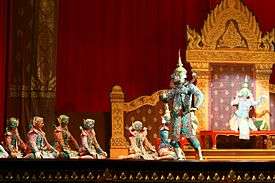
Thailand has the distinction of being one of the leading tourism destinations in the world, renowned for its vibrant cultural heritage and natural beauty.[51] Thai culture features a number of performing arts including drama, Thai dance. Variety shows that feature a number of different theatrical arts are common in Bangkok, Phuket, and Chiang Mai. The “Siam Niramit” show is the most popular Thai cultural show among tourists visiting Thailand. The Siam Niramit show attracts more and more tourists visiting Thailand each year. Theatrical performances of ancient Muay Thai boxing matches, Thai tribal dances, and puppet shows are also popular cultural attractions of Thailand.[52]
Medical tourism
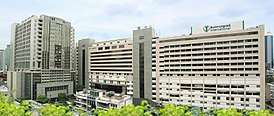
Medical tourism is a large and growing sector within Thailand's extensive tourism and healthcare industries. The country is attractive to potential medical tourists and international patients for a number of important reasons: Thailand was the first Asian country to achieve Joint Commission International (JCI) accreditation in 2002. As of April 2014, 35 hospitals were JCI-accredited.;[54] experienced, often Western-trained, medical professionals; the latest medical technology; and significantly lower costs of treatment when compared to corresponding procedures in the West. Taken together, all these factors—plus the country’s reputation as a popular tourist destination—have made Thailand one of the world's most popular medical tourism destinations.[55]
Some of the primary destinations for medical tourism in Thailand are Bangkok, Chiang Mai, Hua Hin, Ko Samui, Pattaya/Chonburi, and Phuket.[56]
As of 2006 Bumrungrad International Hospital had been mentioned in the world press as a leading medical tourism destination.[57] It was mentioned by www.firstmedicaltourism.com in December 2009.[58] According to bh.listedcompany.com the hospital, served 520,000 international patients from over 190 countries in 2012.[59]
Foreigners seeking treatment for everything from open-heart surgery to gender reassignment have placed Thailand's private hospitals among the world's top destinations for medical tourism, attracting an estimated 2.81 million patients in 2015, up 10.2 percent.[60] In 2013, medical tourists pumped as much as US$4.7 billion into the Thai economy, according to government statistics.[61]
The rise of Chinese tourism, growing 31 percent per year since 2012, has lifted medical tourism throughout ASEAN. Of the 8.7 Chinese tourists who visited Thailand in 2016, some 27,000 came for medical treatment. Numbers are expected to grow by 8 to 10 percent by 2023. Also popular among Chinese patients are Malaysia and Singapore, largely owing to the large numbers of Chinese speakers.[62]
Gastronomical tourism
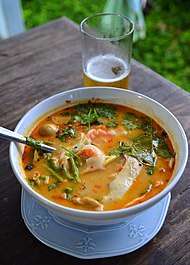
The governor of the Tourism Authority of Thailand (TAT), said the agency aims to increase income from the gastronomy business from 20 percent of total tourism income forecasted for 2017 to 25 percent in 2018. In 2017, TAT aims for 2.77 trillion baht in tourism revenue, 20 percent of which is projected to come from gastronomy. In 2018, tourism revenue is expected to climb to three trillion baht, with gastronomy accounting for 750 billion baht.
TAT, in early-2017, approved a budget of 144 million baht to commission the Michelin Guide to rate restaurants in Thailand for the five-year period 2017–2021. The first guide, Michelin Guide to Bangkok, was released on 6 December 2017. It bestowed Michelin stars on 17 Bangkok restaurants, ten of which do not serve Thai food.[63] Guides to other cities will follow.
In 2016, gastronomy was Thailand's fourth-largest tranche (20 percent) of tourism income, after accommodation (29 percent), transport (27 percent), and shopping and souvenirs (24 percent). TAT estimates that Chinese tourists spent 83.3 billion baht on food in Thailand in 2016, followed by Russians at 20.8 billion baht, Britons at 18.4 billion baht, Malaysians at 16.1 billion baht, and Americans at 13.9 billion baht.[64]
Elephant tourism
Elephant trekking has been an attraction for tourists in Thailand for decades. Ever since logging in Thailand was banned in 1989, elephants were brought into camps to put on shows for tourists and to give them rides. The Asian elephant is the main species found in elephant camps, being native to Thailand and found in the wild there. Despite this elephant being classified as endangered since 1986,[65] it continues to be an attraction for tourists.
History
In the early-1900s there were an estimated 100,000 domesticated or captive elephants in Thailand.[66][67] The majority of these elephants worked in the logging industry, dragging tree trunks. In 1989 the government banned logging in protected areas due to rampant deforestation—only around 30 percent of Thailand's forest remained.[68] Many mahouts were then unable to care for their elephants and left them in the wild. In the five years after the logging ban, tourism in Thailand rose by 28 percent. Elephants came back into demand and those with low economic value were placed into camps. The tourism boom gave elephants a place to work and be cared for. It increased their economic value. Today there are an estimated 3,000 to 4,000 domesticated elephants left in Thailand.[69]
Welfare

Among animal rights groups there has been a growing concern over elephant welfare. Elephants in Thailand have fewer health problems than those in circuses, but often their health is not robust. Overall their welfare and treatment depends on how much money their mahouts make. Elephants in larger camps have been observed in better health that those in smaller camps. Baby elephants are highly valued as they are very popular among tourists.[69] Many mahouts thus mate their female elephants. Unfortunately, natural insemination and birthing is time consuming and expensive. An easy way around this is the illegal capture of baby elephants from wild herds. To be able to take a baby elephant from the herd, its mother needs to be killed as she will try to protect the infant. Baby elephants are then placed in artificial herds to please tourists. Elephants in these herds are often all from different provinces.[68]
Elephants can sustain injuries related to giving rides, or going on treks, with tourists. The elephant's spine is curved and not optimised to carry heavy loads. While they are able to carry up to 300 kilograms, they can only carry a maximum of 200 kilograms comfortably. When tourists ride two at a time they can weigh over that amount. The chairs or benches often used for the tourists to sit on upon the elephant can cause abrasions and chafing on the elephant's back, sides, and torso. During treks mahouts control the elephants with hooks and can use excessive force, resulting in puncture wounds.[69]
Laws
The law pertaining to domesticated elephants is the Beast of Burden Act 2482 B.E. (1939).[70] This act classifies elephants as draught animals along with horses, donkeys, and oxen. It allows domesticated elephants to be treated as private property. This act has no additional measures for animal welfare protection.[69] The Wild Animal Reservation and Protection Act, B.E. 2535 (1992)[71] protects wild elephants, but excludes registered draught animals.[72]
Training
Common training practices include being chained, cut, stabbed, burned and hit to varying degrees. Inexperienced mahouts are more likely to further harm their elephants and beat them into submission.[69] Hooks are the common tool used to discipline and guide an elephant during treks.[68]
Muay thai tourism

Muay Thai is the national sport of Thailand and a trip to a stadium to witness the ‘science of the two limbs’ is an essential part of many tourist’s experience.[73] Muay Thai is a main activity in sports tourism and there is great opportunity in promoting it, as it is another type of tourism that can increase the country’s revenue.[74]
Citing a 2016 survey, the centre said 11,219 British people, 6,800 Australians and 5,852 French nationals visited Thailand to take lessons in the classical martial art. Others arriving to study kick boxing came from Germany 4,688, Sweden 4,253, Russia 2,183, Denmark 1,855, Japan 1,841, New Zealand 1,781 and Spain 1,633.Thirty-eight percent of all the people signing up for muay thai classes chose Phuket as their study destination, 28 per cent Bangkok and 16 percent Surat Thani.[75]
There are two main stadiums in Bangkok, Rajadamnern Stadium and Lumpini Stadium, and the stadium champions at each are generally considered to be the best in their weight class in Thailand. The fights at both venues will almost always be well matched and feature two highly skilled fighters of a similar weight. Like most stadiums in Thailand Rajadamnern allows women to fight but for superstitious reasons Lumpini still does not.[76]
Sex tourism
Of the 26.74 million visitors recorded by TAT in 2013, 11.23 million were men suspected by NGOs to have come to Thailand explicitly to engage in prostitution.[77] Kobkarn Wattanavrangkul, named Thailand's third female tourism minister in 2014, has pledged to eradicate Thailand's sex industry. "We want Thailand to be about quality tourism. We want the sex industry gone," Ms Kobkarn told Reuters. "Tourists don't come to Thailand for [sex]. They come here for our beautiful culture." She has named Pattaya, with its thousands of bars, brothels, and massage parlours, her "pilot project" in the cleanup campaign.[78] Kobkarn was replaced as tourism minister in November 2017.[79]
On 21 February 2017, Prime Minister Gen Prayut Chan-o-cha announced that he will order the police to dismantle Pattaya's sex industry. "I don't support prostitution", said Prayut.[80]
Sex tourism is niche market in Thailand that many tourist visiting Thailand attempt to utilize. There are 30,000 estimated sex workers in Thailand. Because the sex market trades with foreigners, the spread of HIV is big concern for the Thai government.[81]
See also




General
Art and culture
- Prehistoric Thailand
- History of Thailand
- Culture of Thailand
- Ethnic groups in Thailand
- Thai temple art and architecture
- List of Buddhist temples in Thailand
- List of museums in Thailand
- List of World Heritage Sites in Thailand
- Development of the Buddha image in Thailand
- Iconography of Gautama Buddha in Laos and Thailand
- Music of Thailand
- Dance of Thailand
- Thai silk
- Cuisine of Thailand
- Category:Festivals in Thailand
Nature and sports
Language
- Thai language
- Tinglish Thai version of the English language
- Farang Thai word for a foreigner of European ancestry
Tourism
References
- ↑ Theparat, Chatrudee (17 February 2017). "Tourism to continue growth spurt in 2017". Bangkok Post. Retrieved 17 February 2017.
- ↑ "Government moves to head off tourist fears". Bangkok Post. 2015-08-24. Retrieved 24 August 2015.
- ↑ Turner, Rochelle (2015). Travel & Tourism, Economic Impact 2015, Thailand (PDF). London: World Travel & Tourism Council (WTTC). Retrieved 23 August 2016.
- ↑ Global Travel & Tourism Economic Impact World 2018 (PDF). London: World Travel & Tourism Council (WTTC). March 2018. Retrieved 26 August 2018.
- ↑ Becker, Elizabeth (2017-12-02). "Only governments can stem the tide of tourism sweeping the globe". The Guardian. Retrieved 26 August 2018.
- 1 2 "History". TATnews.org. Tourism Authority of Thailand (TAT). 2015. Archived from the original on 14 April 2015. Retrieved 7 May 2015.
- ↑ "How Thailand Became a Tourist Hotspot during the 60's" (Video). Bloomberg. Thailand Business News. 2018-08-30. Retrieved 3 September 2018.
- 1 2 Ouyyanont, Porphant (2001). "The Vietnam War and Tourism in Bangkok's Development, 1960–70" (PDF). Southeast Asian Studies. 39 (2): 157–187.
- ↑ Fuller, Ed. "Thailand: The Land Of Smiles Is Still Smiling After All These Years". Forbes. Retrieved 2018-04-12.
- 1 2 3 "Record 32.59 Million Foreign Tourists Visit Thailand in 2016". Voice of America. Associated Press. 2017-01-31. Retrieved 1 February 2017.
- ↑ Tore, Ozgur (2015-12-23). "Thailand greets 29 millionth visitor in 2015". FTN News. Retrieved 25 December 2015.
- ↑ "Thailand hoping to attract wealthier travellers". The Nation. 2015-12-25. Retrieved 25 December 2015.
- 1 2 3 Chinmaneevong, Chadamas (2016-03-03). "TAT aims to attract rich Chinese tourists". Bangkok Post. Retrieved 3 March 2016.
- 1 2 "International Tourist Arrivals to Thailand 2014 (by nationality)". Department of Tourism (Thailand). Archived from the original on 18 March 2015. Retrieved 10 March 2015.
- ↑ McDowall, Siriporn (1 February 2010). "International Tourist Satisfaction and Destination Loyalty: Bangkok, Thailand". Taylor and Francis Online. Retrieved April 12, 2018.
- 1 2 "Chinese tourists boost Thai economy but stir outrage". The Nation. 2015-07-05. Retrieved 5 July 2015.
- 1 2 "TAT to lure Chinese tourists with military facilities". Bangkok Post. 20 February 2017. Retrieved 21 February 2017.
- ↑ "Thailand Tourism Statistics. Tourist Arrivals from 2000 till 2017. Influence of Epidemics, Political Events (Military Coup), Floods, Economic Downturn on Tourist Arrivals". www.thaiwebsites.com. Retrieved 2018-04-12.
- ↑ Wanwisa Ngamsangchaikit (18 February 2013). "Chinese spend more in Thailand". TTR Weekly. TTR Weekly. Archived from the original on 8 June 2013. Retrieved 3 June 2013.
- ↑ Julie Zhu (3 May 2013). "Chinese tourists flock to Thailand thanks to hit comedy film". Financial Times. Retrieved 3 June 2013.
- ↑ "Guide to Civilised Tourism" (PDF). whiterabbitcollection.org. September 2013. Retrieved April 12, 2018.
- ↑ Suchiva, Nanat (21 February 2017). "Ministry seeks to court more Japanese women". Bangkok Post. Retrieved 22 February 2017.
- ↑ Tourist Police in Thailand Archived 3 July 2008 at the Wayback Machine.. Amazing-Thailand.com. Retrieved on 16 September 2010.
- ↑ "Tourism industry in Thailand | MMH In Asia Master Class in Bangkok". blogs.cornell.edu. Retrieved 2018-04-11.
- ↑ "Phuket Itinerary | Big Buddha, Phuket Night Markets & Bangla Road". Wanderlust Storytellers | Family Travel Blog. 2015-08-19. Retrieved 2017-05-17.
- ↑ Hedrick-Wong, Yuwa; Choong, Desmond (2014). MasterCard 2014 Global Destination Cities Index. MasterCard. p. 3.
- ↑ http://newsroom.mastercard.com/wp-content/uploads/2015/06/MasterCard-GDCI-2015-Final-Report1.pdf
- ↑ "Best Countries 2017" (PDF). US News.
- ↑ The Travel & Tourism Competitiveness Report 2015. Geneva: World Economic Forum (WEF). 2015. pp. 323–325. ISBN 978-92-95044-48-7. Archived from the original on 21 December 2015. Retrieved 7 May 2015.
- ↑ "Poor safety record limits Thailand in world tourism rankings". Bangkok Post. 2015-05-07. Retrieved 7 May 2015.
- ↑ "UNWTO Tourism Highlights". UNWTO (2014 ed.). Madrid: UN World Tourism Organization (UNWTO). 2014. Retrieved 10 March 2015.
- ↑ Euromonitor International (Jan 2010). "Euromonitor International's Top City Destination Ranking". Archived from the original on 1 September 2010. Retrieved 14 October 2010.
- ↑ Jon Russell (28 December 2012). "Suvarnabhumi Airport in Thailand tops Instagram's list of most photographed places in 2012". The Next Web. The Next Web, Inc. Retrieved 3 June 2013.
- ↑ Amnatcharoenrit, Bamrung (2014-01-04). "Tourist help centres to be set up across the city ahead of shutdown". The Nation. Retrieved 4 January 2017.
- 1 2 "2014 Tourist Arrivals in Thailand Drop By 6.6 Percent". Khaosod English. Archived from the original on 9 January 2015. Retrieved 9 January 2015.
- ↑ "Tourism rebounds after martial law ended". ThaiVisa. 5 April 2015. Archived from the original on 7 April 2015. Retrieved 6 April 2015.
- ↑ "2015 Discover Thainess". Amazing Thailand. Tourism Authority of Thailand (TAT). Archived from the original on 9 January 2015. Retrieved 9 January 2015.
- ↑ "More tourists travel "Isan"". National News Bureau of Thailand (NNT). NNT. 13 February 2015. Retrieved 13 February 2015.
- ↑ World Maps of the Köppen-Geiger climate classification updated Archived 6 September 2010 at the Wayback Machine.. Koeppen-geiger.vu-wien.ac.at. Retrieved on 16 September 2010.
- ↑ World Weather Information Service – Thailand. Worldweather.org (16 October 2006). Retrieved on 16 September 2010.
- 1 2 "สถิตินักท่องเที่ยว Visitor Statistics, 1998–2016". Department of Tourism Thailand (in Thai). Retrieved 20 November 2017.
- 1 2 "สถิติด้านการท่องเที่ยว ปี 2560 (Tourism Statistics 2017)". Ministry of Tourism & Sports. Retrieved 16 January 2018.
- ↑ Turner, Rochelle; Freiermuth, Evelyne (March 2018). Travel & Tourism Economic Impact 2017 Thailand (PDF). London: World Travel & Tourism Council (WTTC). Retrieved 2 June 2018.
- 1 2 "International Tourist Arrivals to Thailand (2018)". Ministry of Tourism & Sports. Retrieved 20 September 2018.
- 1 2 Hariraksapitak, Pracha; Temphairojana, Pairat (9 January 2017). "Thailand expects tourism revenue of nearly $50 billion in 2017". Reuters. Retrieved 10 January 2017.
- ↑ "Future of Krabi's power plant unclear". Bangkok Post. 2015-09-27. Retrieved 27 September 2015.
- ↑ "Thailand's hotel occupancy hits 20-year high". eTN Global Travel Industry News. 2016-01-25. Retrieved 26 January 2016.
- ↑ Sakoot, Tanyaluk (2016-01-22). "Going Down: Businesses on Phuket's famed Bangla Rd suffer as clientele dries up". Phuket News. Retrieved 27 January 2016.
- ↑ "Thailand celebrates New Year with 35 million visitors in 2017 – Tourism". Thailand Business News. 2018-01-02. Retrieved 2018-06-21.
- ↑ "Flash floods rain down on holidays". Bangkok Post. 10 January 2017. Retrieved 10 January 2017.
- ↑ "117 proud winners conferred 2015 Thailand Tourism Awards". tatnews.org. Retrieved 28 September 2015.
- ↑ "Types of Tourism in Thailand" (PDF). agrilife.org. Retrieved 5 September 2015.
- ↑ "Outsourcing Your Heart" Time Magazine, 21 May. 2006. Accessed 12 Jan 2008.
- ↑ "Healthcare System and Quality in Thailand". MyMEDHoliday.com. Retrieved 10 March 2015.
- ↑ "Countries that are Considered Top Medical Tourism Destinations in the World". MyMedHoliday.com. MyMEDHoliday.com. 30 April 2013. Retrieved 27 September 2013.
- ↑ "Thailand Medical Tourism". My Med Holiday. MyMEDHoliday.com. 2012–2013. Retrieved 27 September 2013.
- ↑ "Outsourcing Your Heart" Time Magazine, 21 May. 2006. Accessed 12 Jan 2008.
- ↑ "Bumrungrad International Hospital Bangkok"Archived 11 July 2011 at the Wayback Machine. Thailand Medical Tourism, 21 May. 2009. Accessed 12 Oct 2010.
- ↑ "Building for the future: Bumrungrad Hospital Public Company Limited" (PDF). Retrieved 2013-11-29.
- ↑ "Medical Tourism in Thailand: When Treatment Costs and Starbucks Clash". Medical Tourism Magazine. 2015-10-13. Retrieved 14 October 2015.
- ↑ Mellor, William (19 November 2014). "Medical Tourists Flock to Thailand Spurring Post-Coup Economy". Bloomberg. Retrieved 19 February 2015.
- ↑ Luythong, Chettayakhom (2018-07-09). "Healthy Outlook". Bangkok Post. Retrieved 16 July 2018.
- ↑ Pandey, Umesh (10 December 2017). "Michelin guide leaves sour taste" (Editorial). Bangkok Post. Retrieved 10 December 2017.
- ↑ Sritama, Suchat (2017-11-29). "Michelin Guide set to hit Thai tables". Bangkok Post. Retrieved 3 December 2017.
- ↑ Choudhury, A; Lahiri Choudhury, D.K.; Desai, A; et al. "Elephas maximus". The IUCN Red List of Threatened Species. Retrieved 22 February 2017.
- ↑ Tipprasert, Prasob (February 2001). "Elephants and ecotourism in Thailand". In Baker, Iljas. Giants on Our Hands: Proceedings of the International Workshop on the Domesticated Asian Elephant. Food and Agriculture Organization of the United Nations, Regional Office for Asia and the Pacific. ISBN 974-90757-1-4.
- ↑ Lair, Richard C. (1997). Gone Astray—The Care and Management of the Asian Elephant in Domesticity (3d ed.). Rome: Food and Agriculture Office of the United Nations (FAO). ISBN 974-89472-3-8. Retrieved 9 January 2015.
- 1 2 3 Chatkupt, Thomas T; Aollod, Albert E; Sarobol, Sinth (1999). "Elephants in Thailand: Determinants of Health and Welfare in Working Populations". Journal of Applied Animal Welfare Science. 2 (3): 187–203. doi:10.1207/s15327604jaws0203_2. Retrieved 22 February 2017.
- 1 2 3 4 5 Kontogeorgopoulos, Nick (2009). "The Role of Tourism in Elephant Welfare in Northern Thailand" (PDF). Journal of Tourism. Retrieved 10 January 2015.
- ↑ Kanchanapangka, Sumolya (October 2008). "Crucial Factors for the Survival of the Thai Elephant I. Legislation Revision". Proceedings, The 15th Congress of FAVA 27–30 October FAVA -OIE Joint Symposium on Emerging Diseases (PDF). Bangkok: Chulalongkorn University. p. S105-S106. Retrieved 22 February 2017.
- ↑ "Wild Animal Reservation and Protection Act, B.E. 2535 (1992)". Isaan Lawyers. Retrieved 22 February 2017.
- ↑ Schliesinger, Joachim (2010). Elephants in Thailand; Volume 1: Mahouts and their Cultures Today. Bangkok: White Lotus Co., Ltd. p. 9. ISBN 978-1-63323-233-4. Retrieved 22 February 2017.
- ↑ "A tourist's guide to watching Muay Thai in Thailand". travelwireasia.com. Retrieved 25 February 2011.
- ↑ "Tourism and Sports Ministry to support Muay Thai training for foreigners". thephuketnews. Retrieved 7 September 2017.
- ↑ "Muay thai tourism by the numbers". nationmultimedia. Retrieved 5 June 2017.
- ↑ "A tourist's guide to watching Muay Thai in Thailand". travelwireasia.com. Retrieved 25 February 2011.
- ↑ Lines, Lisa (July 2015). "Prostitution in Thailand: Representations in fiction and narrative non-fiction" (PDF). Journal of International Women’s Studies. 16 (3): 86–100. Retrieved 21 March 2018.
- ↑ Marszal, Andrew (17 July 2016). "'Thailand is closed to sex trade', says country's first female tourism minister". The Telegraph. Retrieved 1 February 2017.
- ↑ Hamdi, Raini (28 November 2017). "A familiar face helms Thai tourism but Kobkarn will be missed". TTG Asia. Retrieved 10 January 2018.
- ↑ "Junta to purge Pattaya of prostitution". Prachatai English. 22 February 2017. Retrieved 22 February 2017.
- ↑ Van Kerkwijk, C. (October 1992). "Sex Tourism in Thailand". AIDS & Society. 4 (1): 6–7. ISSN 1055-0380. PMID 12286018.
- ↑ "The History of Thai Fruit and Vegetable Carving". Archived from the original on 25 November 2015. Retrieved 11 December 2014.
External links

| Wikimedia Commons has media related to Tourism in Thailand. |
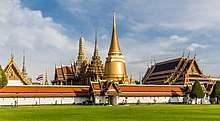
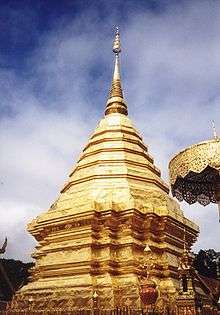
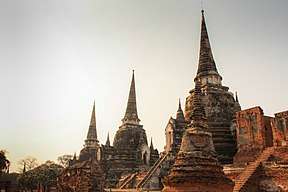
.jpg)



